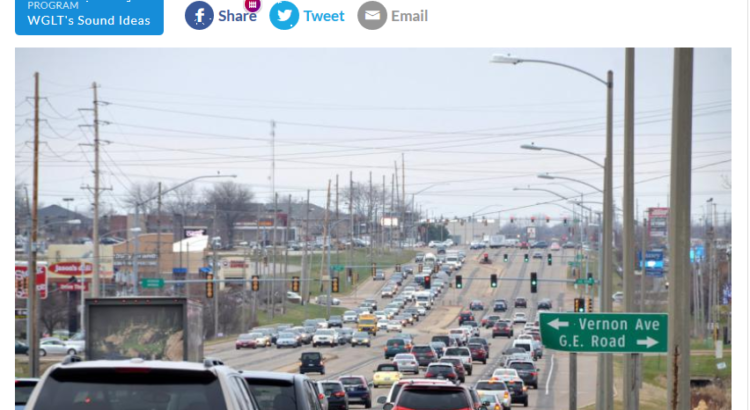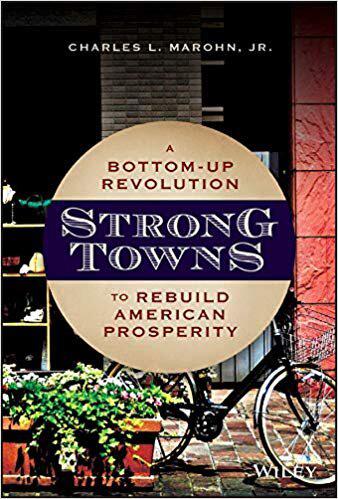The outlook is not good for the nation’s cities if current trends continue. (Podcast on site)
That’s according to Charles Marohn Jr., the author of the new book “Strong Towns: A Bottom-Up Revolution To Rebuild American Prosperity.” He’s also the head of Strong Towns, a not-for-profit organization that talks about urban issues.
In his book, Marohn writes that North America’s modern development pattern—cul-de-sacs, big-box stores and business parks rapidly spreading outside the city core—was built on the wave of post-World War II prosperity that has since waned.
Speaking on WGLT’s Sound Ideas, Marohn said over time, continuing to extend water, sewer and roads to these far edges of communities will leave cities bankrupt. That’s because the revenue generated by these developments isn’t enough to offset the cost to maintain and replace the infrastructure that serves it.
“I live in Brainerd, Minn. It’s about 14,000 people,” Marohn said. “We have more annual debt service than we actually collect in revenue.”
And that means that revenue certainly can’t pay for other municipal services like police, firefighters and libraries, he said. “That is money that comes from other sources, the state and federal government largely.”
As recent state budget crises demonstrate—Minnesota in 2011, Illinois from 2015 to 2017, both with vast cuts to local spending—“this is a very fragile and tenuous situation that could, at the local government level, go bad in a hurry,” Marohn said.
So what’s a city to do?
Marohn said local governments don’t have to be a party to the growth machine. He offered Brainerd’s airport as an example.
“We were given 90 cents on the dollar to do a massive infrastructure project to run sewer and water out to our airport at the edge of town,” he said. Once completed, all that infrastructure was up to the city to maintain, on top of the couple million dollars it spent to match federal subsidies.
“If we instead took our resources and our capacity and focused on our neighborhoods, our places where people live, our businesses that are starting to operate and trying to operate, and we just focused on, how do we deal with the day-to-day struggles that people are having there, we could spend a fraction of that dollar amount and have projects that paid a huge financial return,” he said.
Marohn offered one method for local governments to determine a project’s return on investment: calculate its financial productivity or value per acre. Putting up a Walmart on the edge of town may sound like a lucrative venture, for example.
“When you look at the revenue you get from that, it’s substantial, it’s a big piece of property,” Marohn said. “But it also costs an extreme amount to provide this service to. When you balance those out, it’s a financial net loser.”
Compare that to an existing building downtown, he continued: “Even when it’s nondescript and kind of rundown, it might not generate a lot of tax revenue, but it also doesn’t cost very much … the Walmart brings in $500,000 or a million dollars of revenue a year, and that little place downtown just brings in $4,000 or $5,000. Sure, but you lose money on the Walmart because it costs more to provide service to and the one downtown you actually make money on.”
Another way to move from growth for growth’s sake to addressing the community’s needs: “Look at where people struggle, observe them and actually, in a biblical sense, walk a mile in their shoes and experience their lives as they experience them,” Marohn said.
Next step, identify the smallest fix to address the problem. “Something literally with paint and duct tape and straw bales and cones to address that struggle,” Marohn said. “The third thing is to go out and get it done, it shouldn’t take much, it’s a little tiny step, and then the fourth step is just to repeat that process over and over.”
Marohn offered the “15-minute neighborhood” as a model of a community that addresses the needs of its residents in this way.”
“So the idea of a 15-minute neighborhood is to say, how many things that you do in a typical day can we start to put back in your neighborhood?” he said. “So that you have options. Sure you can drive to the grocery store out on the edge of town, but maybe you could just walk three blocks and get the same stuff.”
A community like that could not only allow residents to cut expenses by driving less; it would also be more accessible for residents who can’t afford to drive, Marohn said.
Marohn also addressed the idea that the small businesses that support the 15-minute neighborhood can no longer thrive in everything-now era of Amazon, saying it’s actually brought about a bit of a small-business renaissance.
“The biggest industry threatened by Amazon is not the small business, it’s the big-box stores,” he said. Amazon also allows residents to maintain urban lifestyles in communities that lack box-store conveniences, Marohn said.
“I get my deodorant and shampoo and toothpaste delivered by Amazon. I also walk to the local bakery and the local shops. They don’t carry that stuff here, and they really couldn’t carry it profitably.”
And there are still some things Amazon can’t do.
“There’s a lot of other things, supplemental things that you can do here as a small business that requires that personal touch, that require that service, or maybe a little more value-added product,” Marohn said.
Placing more of the locations residents frequent within a single neighborhood is also a kind of risk management, Marohn explained.
“It’s really a tradeoff between efficiency and resiliency,” he said. Marohn gave the example of Old English and Peruvian farmers who planted their crops in multiple plots across the landscape rather than clustered in a single location. The likelihood that every single crop would be wiped out and the farmers would starve was greatly reduced.
Compare that strategy to the effects of the Great Recession, Marohn said. “In 2008, Nancy Pelosi, George Bush and a whole cadre of officials came to us and said, ‘If we don’t spend a trillion dollars in the next 48 hours, there will not be food on the grocery store shelves in the next three days.’ The idea that that was a possibility in our economy … that should have been a huge wake-up call for us.”
With the new decade already full of historic political happenings, calling elected officials’ attention to America’s fragile cities can be difficult, Marohn said.
“I think that if you want to make this an urgent thing, you need to in a sense intentionally opt out of the big circus that’s drawing our attention away and just go out and actually experience the struggles that people have in the community.”


